Overview
The title "10 Strategies to Enhance Deal Sourcing Workflows with Talent Data" poses a critical question: how can organizations effectively improve their deal sourcing processes through the use of talent data? This article presents several powerful strategies designed to elevate recruitment efficiency and effectiveness. By leveraging AI-driven tools for data enrichment, employing structured outreach, and enhancing employer branding, organizations can significantly enhance their ability to identify, engage, and retain top talent. These strategies not only streamline workflows but also foster a more competitive edge in the talent market.
Introduction
The landscape of recruitment is undergoing a significant transformation, propelled by the integration of advanced technology and data-driven strategies. Organizations are increasingly acknowledging the immense potential of talent data to enhance deal sourcing workflows, resulting in improved hiring outcomes and heightened efficiency. However, as companies navigate this intricate terrain, they encounter the challenge of effectively leveraging these tools to attract and retain top talent.
What strategies can organizations employ to optimize their recruitment processes and maintain competitiveness in a saturated market? This article delves into ten innovative approaches aimed at enhancing deal sourcing workflows, harnessing the power of talent data to revolutionize hiring practices.
Websets: AI-Driven Talent Data Solutions for Enhanced Deal Sourcing Workflows
The platform harnesses advanced AI algorithms to optimize deal sourcing workflows with talent data, delivering precise and enriched results. Its robust search engine empowers users to sift through extensive datasets, enabling sales teams and recruiters to efficiently pinpoint the most suitable leads and candidates. By integrating comprehensive details such as LinkedIn profiles and prior work experience, Websets significantly enhances the quality of data available for informed decision-making. This strategic approach and drives improved outcomes in sales efforts. Indeed, organizations that align AI tools with clear goals have reported up to a 48% increase in diversity hiring effectiveness and a 30-40% reduction in cost-per-hire. This highlights the transformative impact of AI on hiring efficiency. As industry leaders observe, the future of hiring is not merely AI-assisted; it is fundamentally AI-driven, reshaping how talent is sourced and evaluated.
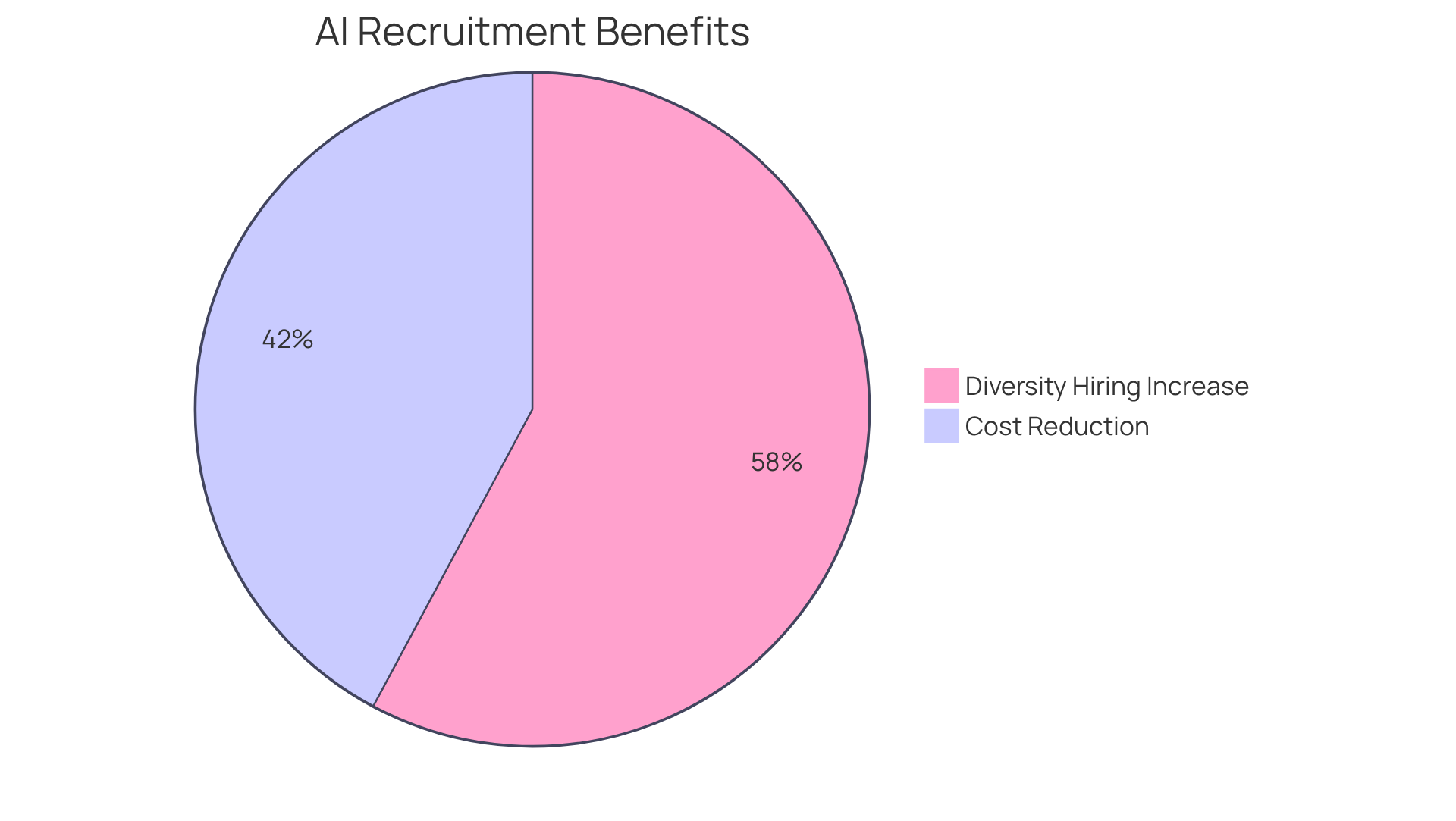
Lever.co: Candidate Sourcing Strategies to Optimize Recruitment Efforts
The platform offers a comprehensive suite of strategies for talent acquisition designed to elevate recruitment initiatives. By leveraging advanced AI-driven tools, organizations can identify companies and individuals that fulfill hyper-specific criteria. Collaborating closely with hiring managers allows for a deeper understanding of their needs, while diversifying sourcing channels enhances reach.
Utilizing data from (ATS) and unique features empowers organizations to refine their talent acquisition processes by implementing deal sourcing workflows with talent data, attracting exceptional individuals with hard-to-describe attributes that align with specific requirements.
Additionally, Websets provides live demonstrations of its tools, showcasing practical applications that can significantly enhance hiring processes.
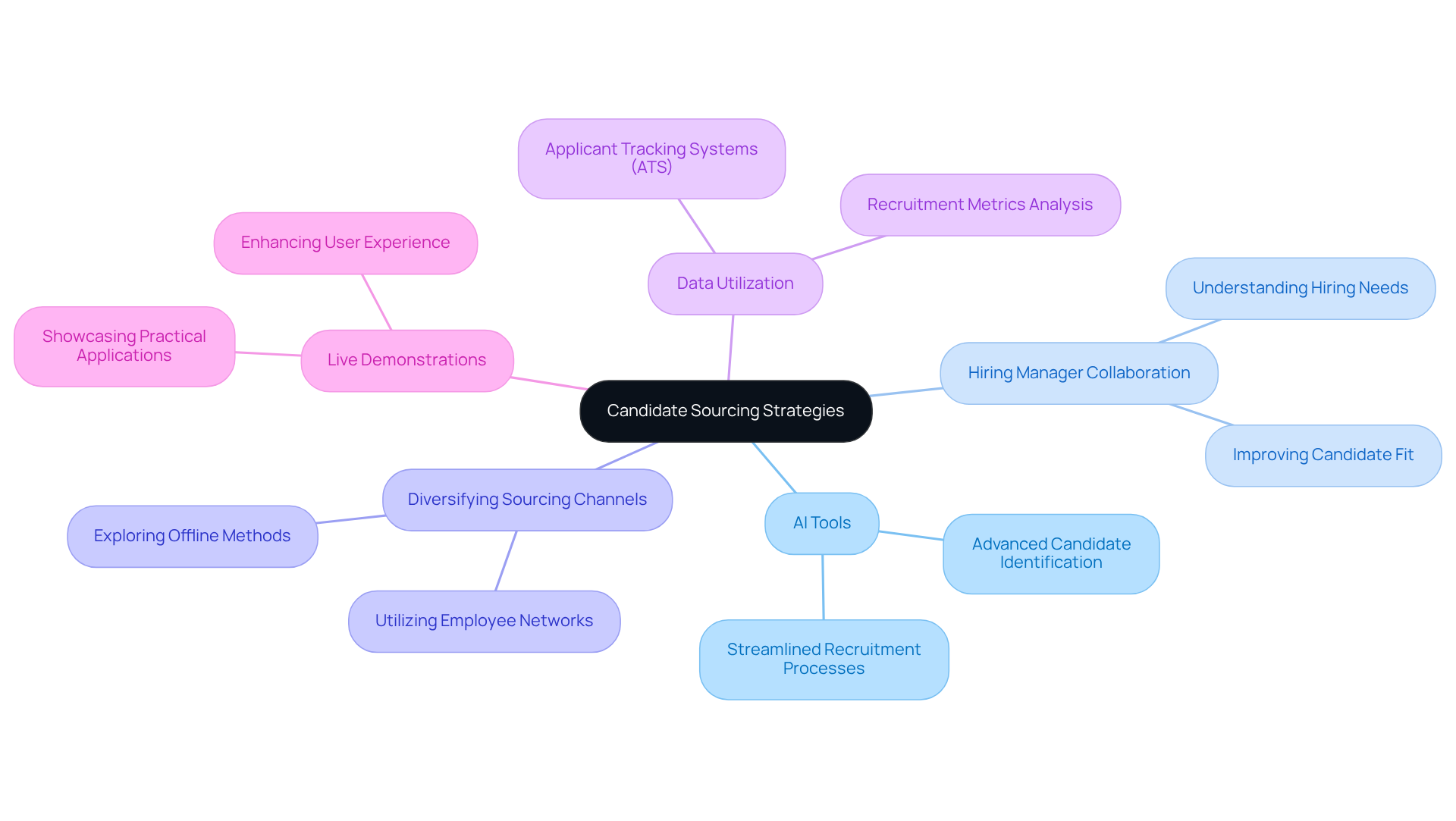
Coresignal.com: Comprehensive Guide to Types of Deal Sourcing for Recruitment
Coresignal.com outlines various methods of deal acquisition for recruitment, including direct approaches, referral methods, and passive talent acquisition. Each method presents distinct advantages, tailored to meet specific organizational needs.
- Direct recruitment involves proactively identifying and engaging potential candidates, often resulting in a higher quality of hire.
- Conversely, referral recruitment leverages the networks of current employees, yielding candidates who typically align better with the company culture and exhibit a greater likelihood of long-term retention. Notably, statistics indicate that referred candidates are four times more likely to secure a position compared to those sourced through traditional methods, and they tend to be 25% more profitable for their employers.
Organizations such as Microsoft have successfully implemented passive candidate recruitment, targeting individuals who may not be actively pursuing new opportunities yet possess the requisite skills and experience. This strategy effectively taps into a broader talent pool, particularly in competitive markets. Anne Carrigan, Talent Acquisition Director at Microsoft, asserts that recruiters play a pivotal role in empowering organizations by nurturing talent, a critical component for sustained success.
Recruitment specialists emphasize the importance of balancing these acquisition strategies. For instance, Jack Welch noted that surrounding oneself with exceptional individuals is essential for effective leadership, underscoring the significance of both direct and referral recruitment in building strong teams. Furthermore, data reveals that companies employing a combination of procurement methods can enhance their overall recruitment success rates, ensuring they attract the right talent efficiently. However, it is crucial to consider potential downsides of employee referrals, such as biases or negative workplace politics, which can adversely affect team dynamics.
Ultimately, understanding these procurement types enables recruiters to and optimize their deal sourcing workflows with talent data, leading to superior outcomes in their hiring efforts.
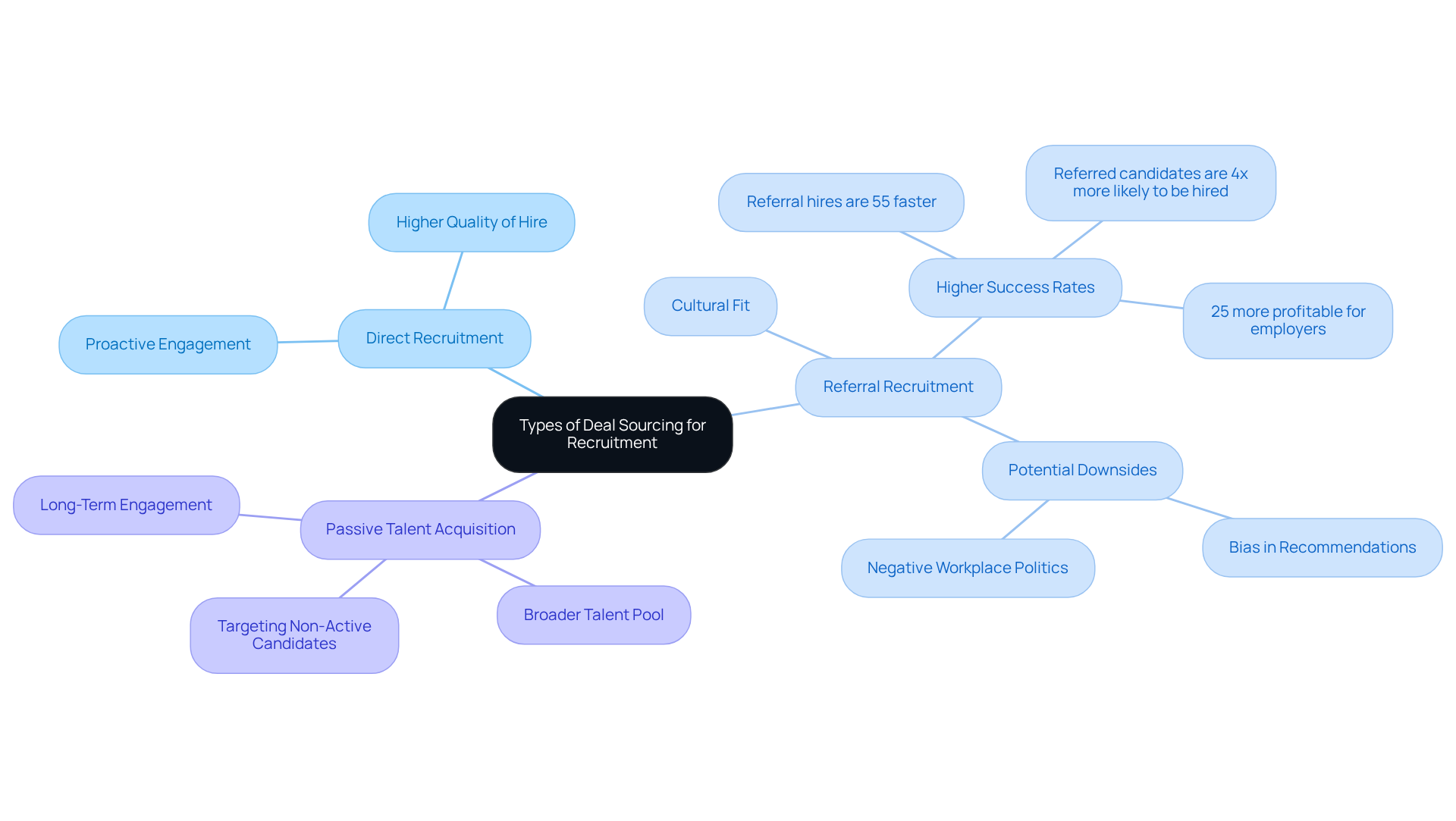
LinkedIn: Leveraging Professional Networks for Effective Candidate Sourcing
LinkedIn emerges as an indispensable tool for talent sourcing, empowering recruiters to tap into a vast network of professionals. By harnessing advanced search functionalities, including AI-driven neural search capabilities provided by Websets, organizations can significantly elevate their recruitment strategies. Neural search goes beyond conventional keyword-based approaches, offering a nuanced understanding of potential queries that captures the semantic essence of a search. This innovation enables recruiters to engage prospective applicants through personalized outreach strategies, nurturing relationships and attracting top-tier talent. Tailored communication has proven to enhance response rates substantially, with data indicating that such methods can increase participant engagement by as much as 50%.
Additionally, LinkedIn facilitates companies in effectively showcasing their culture and values, which is vital for attracting talent aligned with organizational goals. Successful organizations have leveraged LinkedIn to emphasize their distinctive workplace environments, resulting in enhanced employer branding and a deeper connection with potential hires. For instance, a leading SaaS sales hiring agency experienced an extraordinary 150% growth in team size by implementing targeted LinkedIn strategies, underscoring the power of technology in recruitment efforts.
Recruiters stress the significance of cultivating relationships through strategic outreach. As one recruiter noted, "The key to successful hiring on LinkedIn is not merely about filling roles but nurturing relationships that align with individuals' aspirations." This perspective underscores a shift towards a more , where understanding candidates' motivations can yield improved employment outcomes. Furthermore, treating hiring as a sales process and honing communication, persuasion, and relationship-building skills are essential for effective outreach.
Numerous organizations have successfully leveraged LinkedIn's capabilities to enhance their deal sourcing workflows with talent data for hiring initiatives. Cooper Coleman, a non-profit executive search firm, doubled its executive placements by optimizing operations with Websets' solutions, illustrating the transformative impact of strategic hiring efforts. Such success stories demonstrate the platform's potential in revolutionizing hiring processes and driving organizational growth.
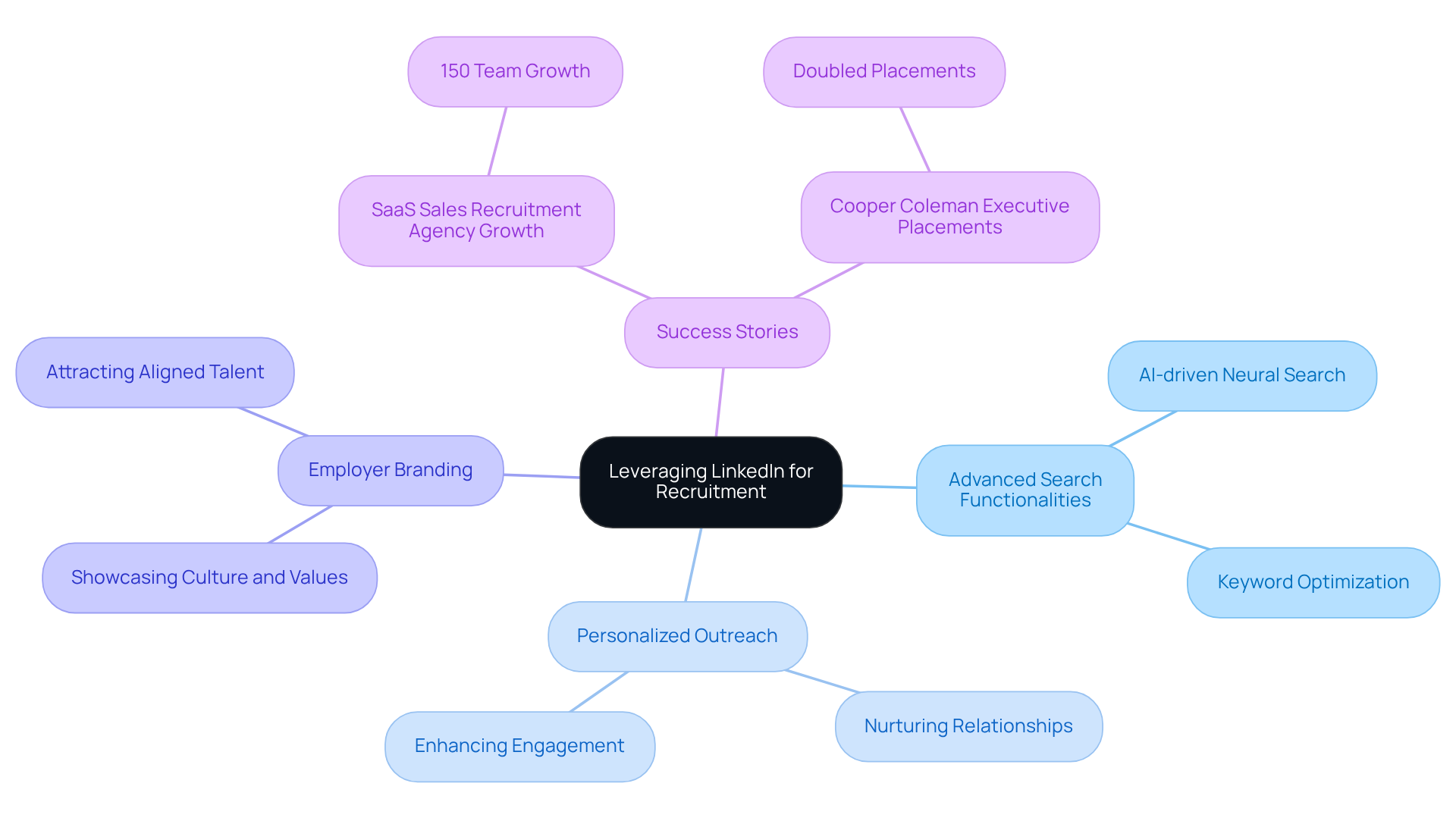
AI-Powered Tools: Streamlining Recruitment Processes for Better Deal Sourcing
AI-powered tools are fundamentally transforming recruitment by automating repetitive tasks and delivering data-driven insights. The advanced AI search engine is specifically designed to analyze vast amounts of applicant data, enabling organizations to predict hiring outcomes and significantly enhance deal sourcing workflows with talent data. Teams leveraging Websets have reported reductions in time spent on manual tasks; some studies indicate that AI can reduce the cost and time to recruit by up to 90%. This shift allows recruiters to focus on establishing rather than being overwhelmed by administrative tasks.
According to Deloitte, AI agent proliferation is expected to double by 2027, with 92% of organizations planning to increase their AI investments by 2025. This evolution not only streamlines workflows but also enhances participant engagement and satisfaction. As Brett Coin states, "AI recruiting tools can significantly lessen recruiter workload by swiftly generating a shortlist of suitable individuals for job positions." This platform enhances the recruitment process by providing accurate talent discovery and qualification, filtering by skills, experience, and location to find the ideal match for open positions.
The automation of sourcing tasks can lead to quicker hiring processes and improved alignment of applicants with organizational needs. Currently, 33% of companies are using AI in HR processes, according to Deloitte. However, it is essential to remain aware of potential risks, such as algorithmic bias, to ensure a balanced approach to AI integration. Overall, these advancements, particularly through customizable search solutions, are driving improved outcomes in talent acquisition.
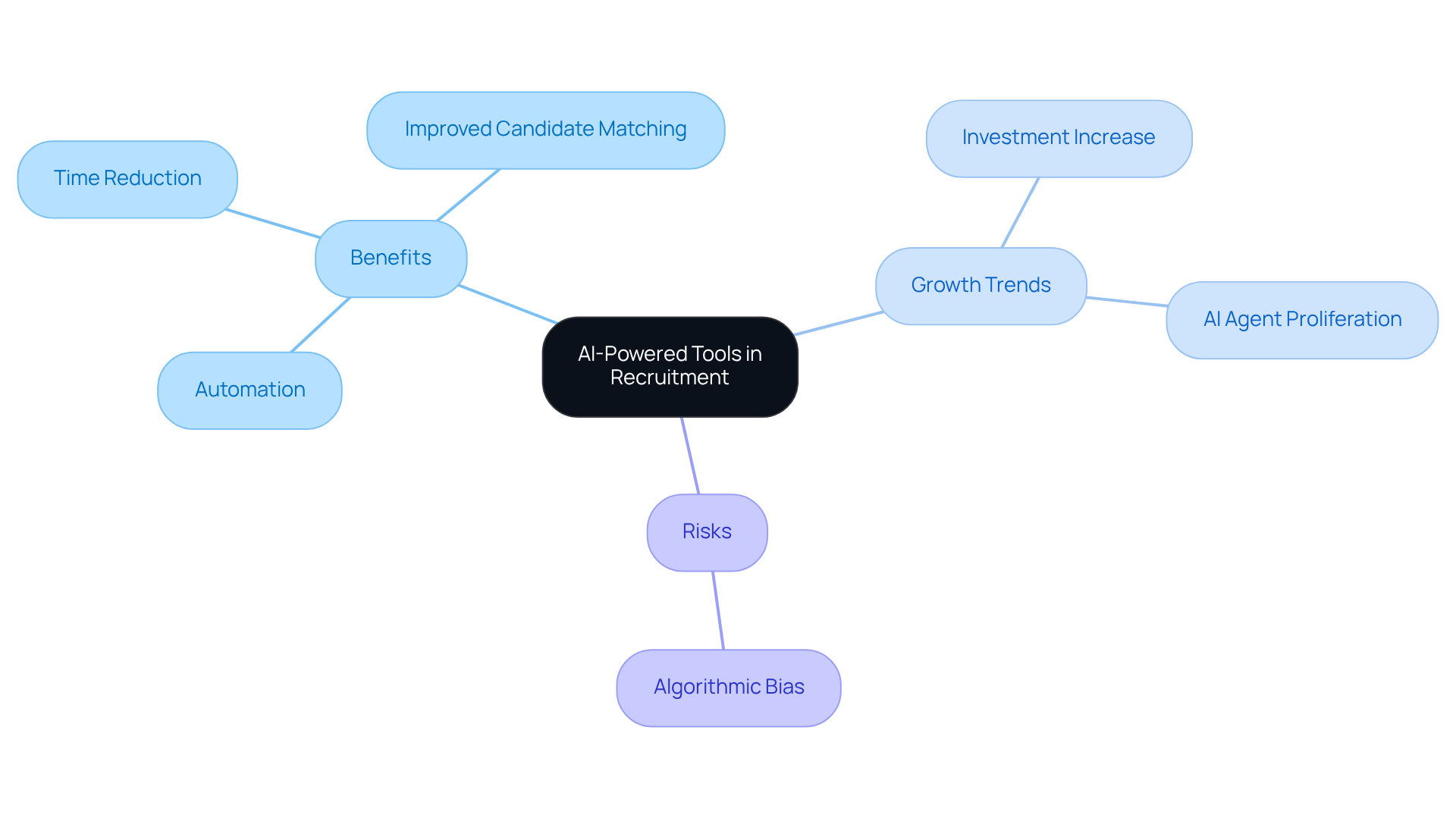
Data Enrichment: Enhancing Candidate Profiles for Improved Deal Sourcing
Data enrichment stands as a vital procedure that significantly enhances profiles by integrating additional details such as skills, experiences, and social media presence. Tools focused on delivering enhanced data, particularly specific platforms, utilize to manage incoming applications and provide comprehensive insights into applicants. This capability enables recruiters to cultivate a more holistic view of candidates, thereby substantially increasing the likelihood of successful placements.
Organizations leveraging enhanced data through these platforms have reported notable improvements, including increased fill rates and better cultural alignment among new hires. In fact, 93% of Fortune 500 Chief Human Resource Officers have adopted AI tools to refine their hiring practices. As Glen Cathey, SVP of Consulting Principal, aptly noted, "Recruiters are drowning. By some estimates, applicant volumes have skyrocketed by 500%, meanwhile recruiting teams have actually shrunk, creating a perfect storm of too many applications and too few hands to process them."
In this evolving hiring landscape, the integration of enriched data via platforms will be crucial for organizations aiming to enhance their deal sourcing workflows with talent data and secure a competitive edge in a saturated market.
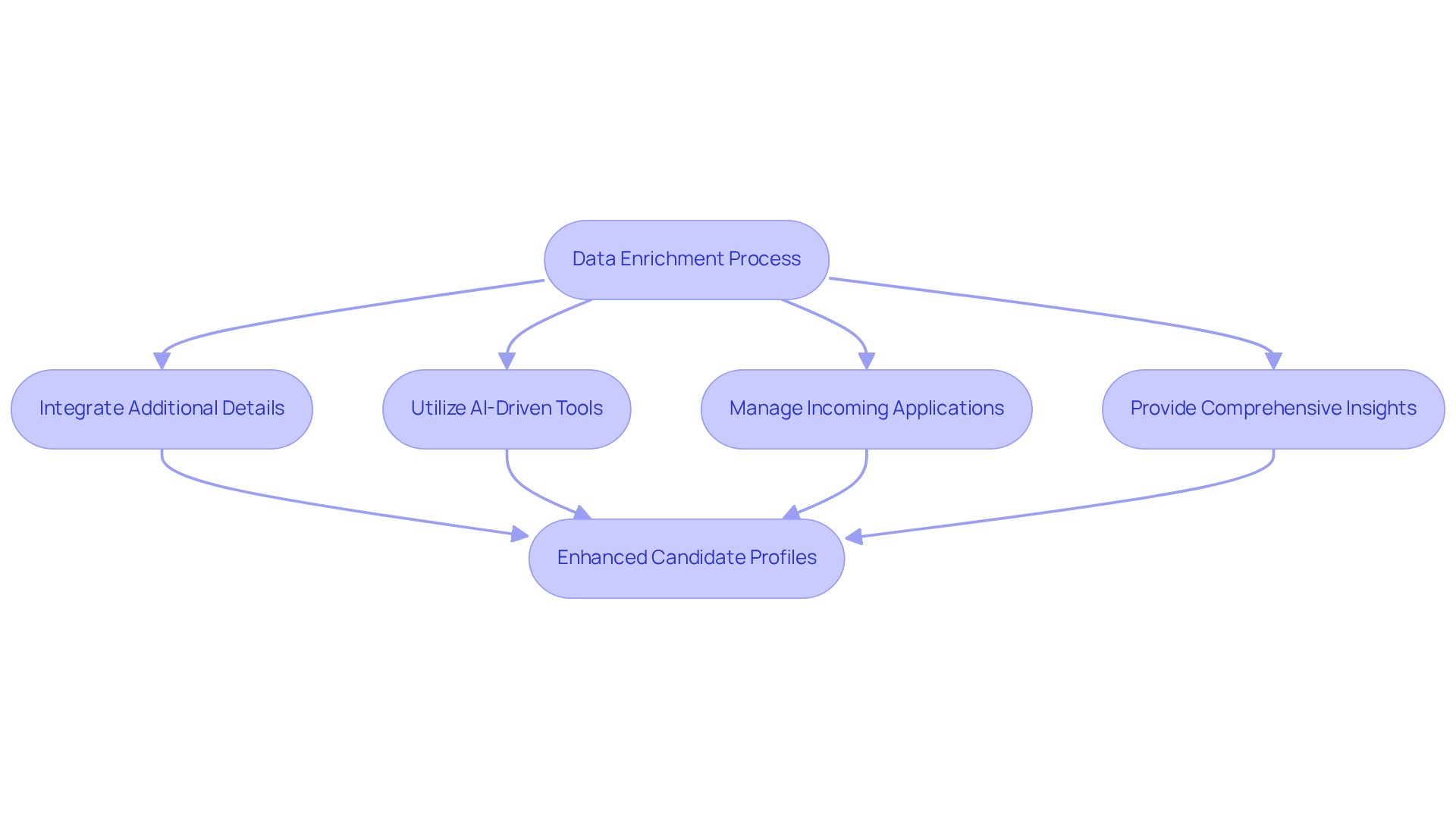
Sales Intelligence Tools: Identifying Leads and Candidates for Deal Sourcing
Sales intelligence tools are indispensable for identifying potential leads and applicants throughout the recruitment process. AI-driven solutions provide significant insights into market trends, competitor actions, and applicant behaviors, empowering recruiters to make informed decisions based on data. For instance, organizations that effectively utilize Websets can tap into emerging market trends, allowing them to find individuals who align with current demands. This strategic approach not only enhances the ability to attract top talent but also fosters engagement with candidates actively seeking opportunities.
Industry leaders underscore the importance of integrating sales intelligence into sourcing strategies. As Patricia Fripp asserts, viewing every interaction as a chance to build a relationship rather than merely a transaction can lead to more meaningful connections. Similarly, Mike King advocates for long-term engagement strategies, emphasizing that understanding market dynamics is crucial for cultivating relationships that yield fruitful partnerships. Furthermore, Anthony Iannarino highlights that genuine concern for customer well-being is essential in generating value in business connections, a principle that also pertains to hiring.
Moreover, leveraging sales intelligence can streamline the hiring process. By analyzing data on sourcing channels, organizations can identify which platforms yield the best applicants, thereby enhancing their hiring efforts. Firms employing automation in hiring report a 30% reduction in time-to-hire, illustrating the efficiency gains from these tools. This data-driven approach not only boosts efficiency but also enriches the overall applicant experience, as recruiters can tailor their outreach based on insights gleaned from AI-powered analytics.
In summary, incorporating sales intelligence into hiring strategies is vital for organizations looking to refine their deal sourcing workflows. By identifying leads and candidates through informed analysis with alternative tools, businesses can create a more effective and engaging hiring process, ultimately driving superior results in talent acquisition. To further enhance hiring initiatives, organizations should routinely to pinpoint slow points in their process and address potential biases in AI hiring tools, as 48% of HR professionals express concerns regarding these biases. Additionally, incorporating specific case studies from Websets' clients could effectively illustrate the practical benefits of these tools in real-world scenarios.
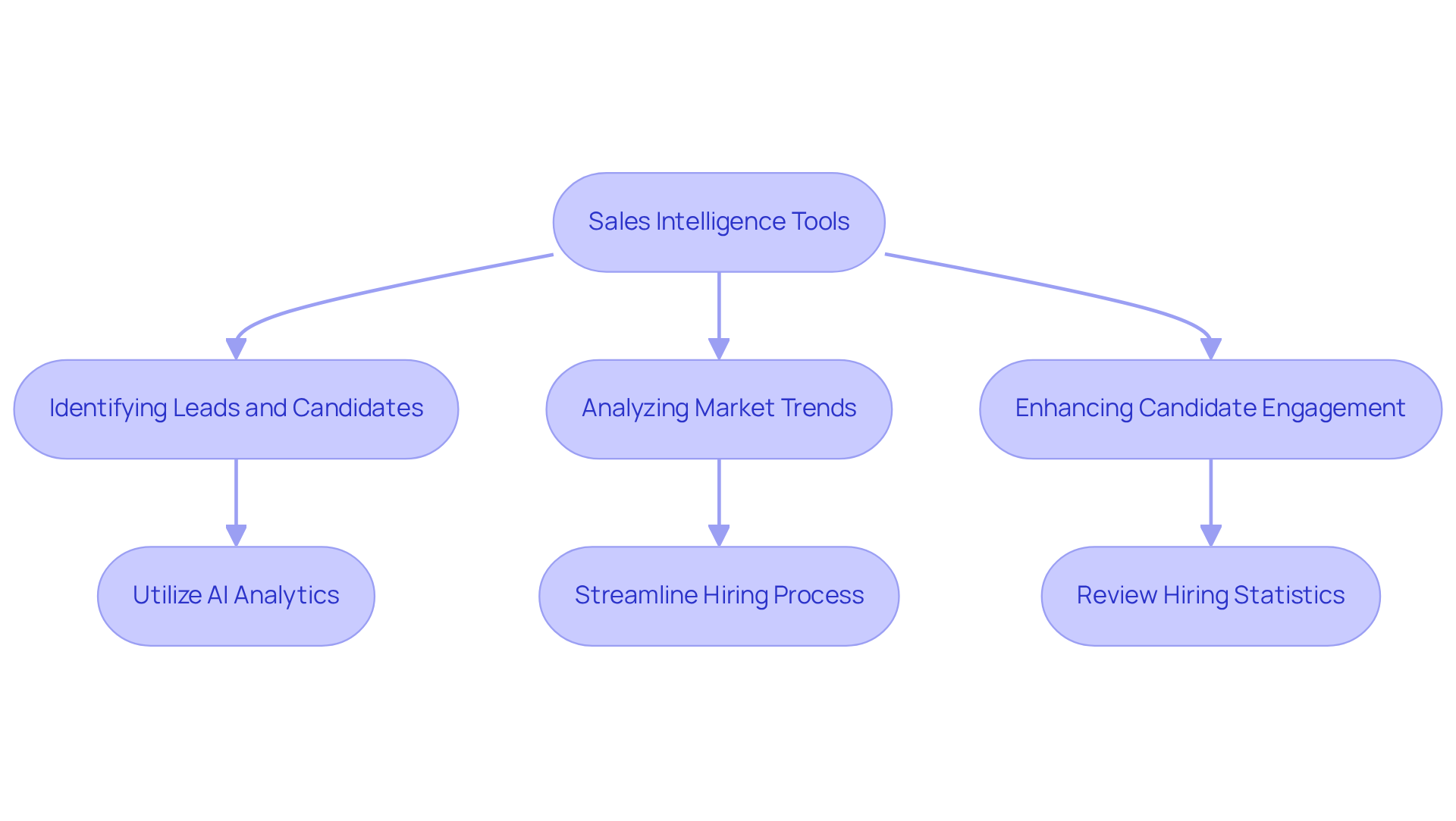
Structured Outreach: Engaging Candidates Effectively in Deal Sourcing
Organized outreach is essential for effectively engaging applicants throughout the recruitment process. This strategic approach involves:
- Crafting personalized messaging
- Ensuring timely follow-ups
- Leveraging diverse communication channels to create a seamless experience for potential hires
By implementing structured outreach strategies, recruiters can significantly enhance applicant engagement, ensuring individuals feel valued and informed at every stage of their journey.
Customized communication plays a pivotal role in this process, enabling recruiters to connect with applicants on a deeper level. Data indicates that personalized communication leads to higher response rates and improved participant satisfaction. For instance, recruiters employing tailored outreach techniques report a significant increase in engagement metrics, underscoring the effectiveness of this strategy. Furthermore, AI-driven tools from this platform can enhance this process by providing insights into candidate preferences and behaviors, allowing for even more tailored communication.
Recruiters stress the importance of , with many advocating for a blend of technology and human touch. As one industry leader remarked, "Conversations remind you of the importance of knowledge and networking, especially when entering new markets." This statement underscores the necessity for recruiters to cultivate genuine connections while leveraging data-driven insights to guide their outreach efforts. By utilizing the advanced search capabilities and analytics of the platform, organizations can optimize their deal sourcing workflows and attract top talent more effectively. Moreover, incorporating AI into hiring processes offers a unique advantage in a competitive market, further enhancing the effectiveness of outreach strategies. By prioritizing personalized messaging and organized interactions, organizations can leverage Websets' tools to enhance applicant engagement and streamline their recruitment efforts.
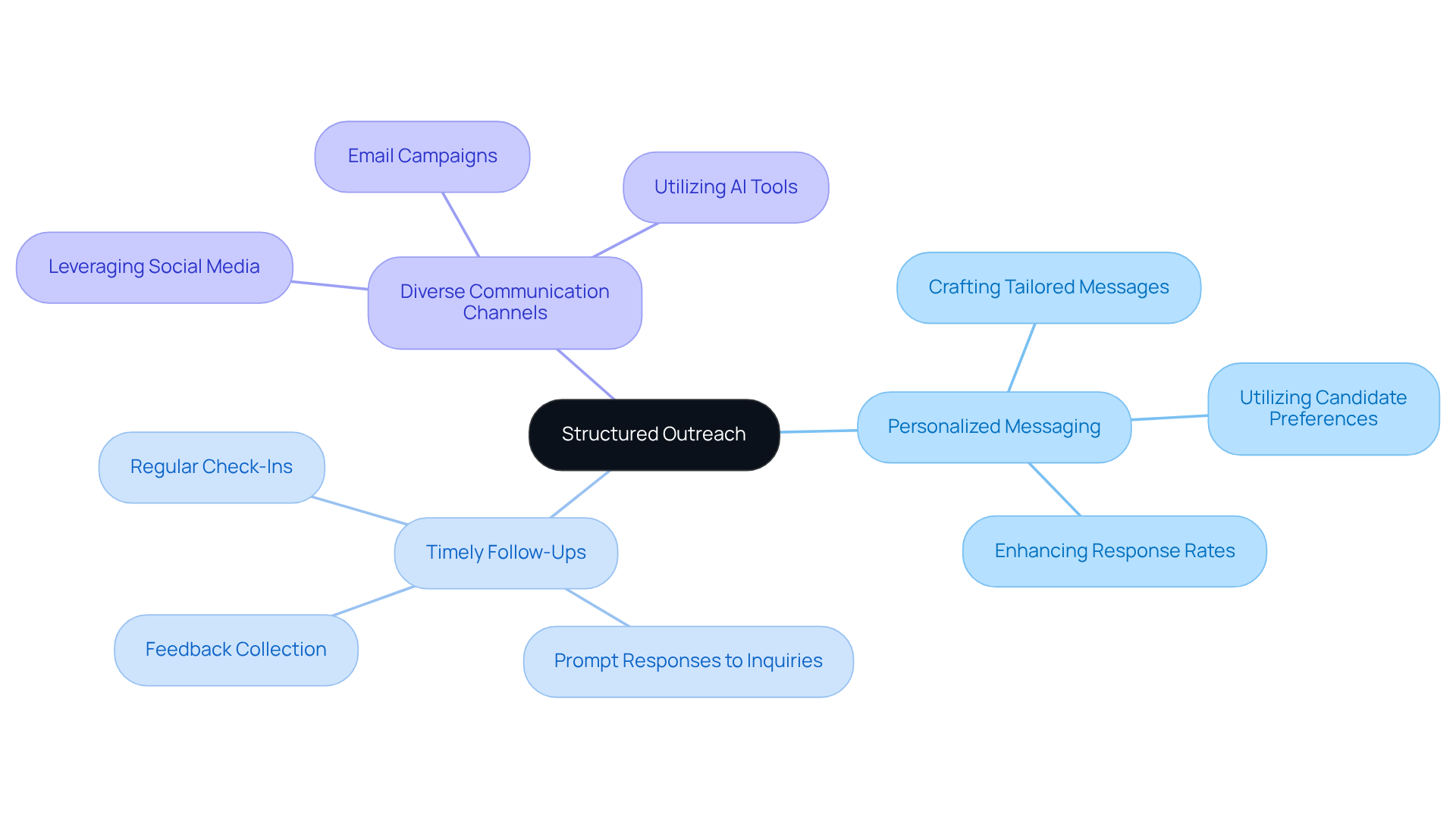
Performance Metrics: Measuring Success in Deal Sourcing Workflows
Performance metrics are crucial for evaluating the success of deal sourcing workflows with talent data. Key metrics include:
- Time-to-fill
- Applicant quality
- Channel effectiveness
- Origin of hire
Time-to-fill measures the duration from job opening initiation to offer acceptance; shorter times indicate greater agility in recruitment. Quality of hire, assessed through performance ratings, provides insights into the effectiveness of recruitment strategies, highlighting the importance of not just acquiring talent but also retaining it. Furthermore, analyzing channel effectiveness enables organizations to identify which routes yield the highest quality applicants, allowing for more strategic resource allocation. The metric tracks where successful candidates come from, offering valuable insights into effective recruitment channels.
Regular analysis of these metrics empowers organizations to spot trends and evaluate the effectiveness of their deal sourcing workflows with talent data. A high conversion rate signals effective engagement and onboarding, while a low offer acceptance rate may indicate compensation issues that need addressing early in the process. Additionally, candidate engagement metrics gauge interaction levels with job postings and outreach efforts, informing communication strategies and enhancing candidate responsiveness. The cost per hire metric, calculated by dividing total acquisition costs by the number of successful hires, aids in budget allocation and provides a financial perspective on hiring effectiveness. By leveraging these insights, organizations can make data-driven adjustments to improve their recruitment outcomes, ensuring they stay competitive in a challenging talent landscape.
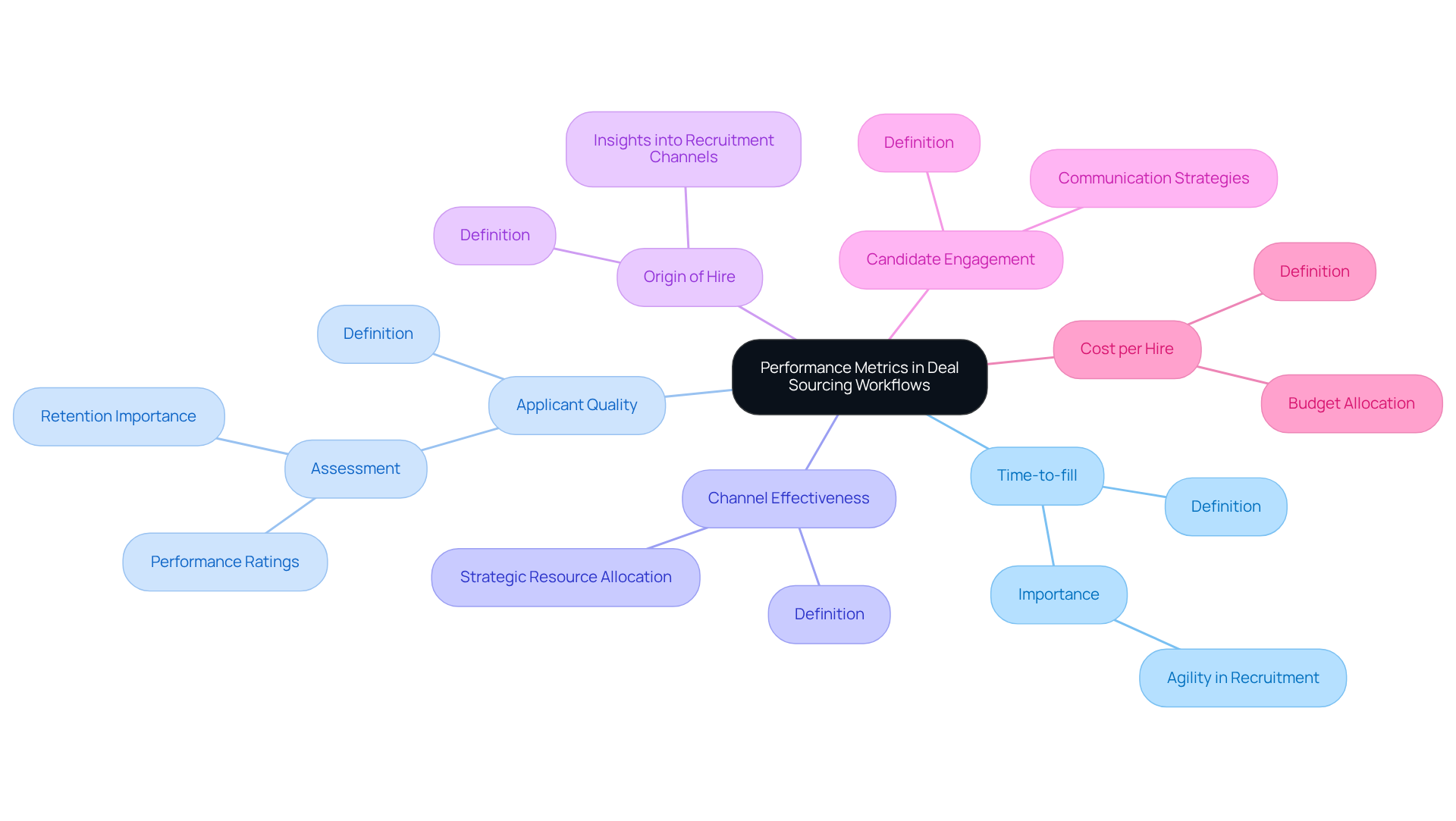
Employer Branding: Attracting Top Talent for Effective Deal Sourcing
Employer branding is crucial for attracting top talent through deal sourcing workflows with talent data. By emphasizing company culture, values, and employee testimonials, organizations can craft a compelling narrative that resonates with potential applicants. A robust employer brand not only draws high-quality candidates but also cultivates loyalty and engagement among current employees, ultimately boosting recruitment success. Notably, research indicates that:
- 84% of job applicants consider a company's reputation when deciding where to apply.
- 84% of businesses believe that strong employer branding aids in attracting high-quality talent.
- 61% of employees would leave their current employer for one with a stronger brand, underscoring the competitive nature of employer branding and its direct influence on retention.
Companies like Adobe and Netflix illustrate this effectively by showcasing their innovative cultures and employee-centric policies, which have successfully attracted skilled professionals. HR professionals assert that a can lead to a 28% increase in retention rates, with effective employer branding contributing to this decrease in turnover. Additionally, with 94% of recruiters actively utilizing social media, organizations must capitalize on these platforms to effectively highlight their culture and values.
As the landscape of talent acquisition evolves, particularly with an increasing emphasis on flexibility and work-life balance, organizations must prioritize their employer branding efforts to remain competitive and attract the best candidates.
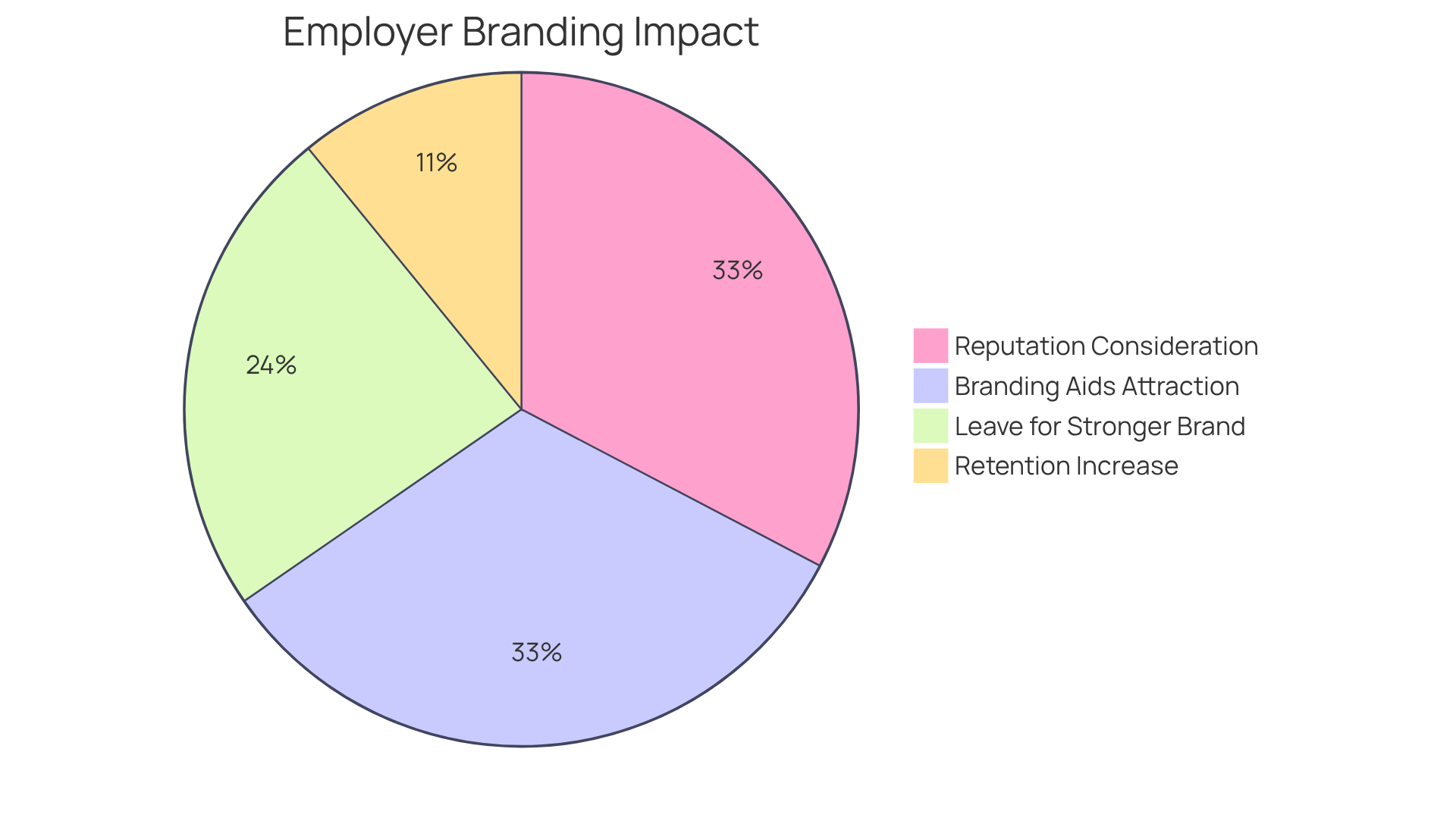
Conclusion
The integration of talent data into deal sourcing workflows has emerged as a game-changer for organizations striving to elevate their recruitment strategies. By leveraging advanced technologies and innovative methods, companies can streamline their hiring processes, enhance candidate engagement, and ultimately secure the best talent available. The emphasis on AI-driven solutions, data enrichment, and structured outreach exemplifies the transformative potential of modern recruitment practices.
Various strategies have been explored, including:
- The utilization of AI tools like Websets for data optimization
- The significance of sales intelligence in identifying leads
- The critical role of employer branding in attracting top candidates
Each approach offers distinct advantages, from improving the quality of hires to reducing time-to-fill metrics. The insights gained from implementing these strategies not only enhance recruitment outcomes but also foster a more efficient and effective hiring environment.
In a competitive talent landscape, organizations must prioritize the adoption of these innovative deal sourcing techniques. By embracing AI technology, refining outreach efforts, and cultivating a strong employer brand, companies can position themselves as leaders in talent acquisition. The future of recruitment lies in the ability to adapt and innovate, ensuring that the right talent is sourced effectively and efficiently. It is imperative for organizations to continuously evaluate and enhance their recruitment strategies to remain competitive and attract the best candidates in an ever-evolving market.
Frequently Asked Questions
What is Websets and how does it enhance deal sourcing workflows?
Websets is a platform that utilizes advanced AI algorithms to optimize deal sourcing workflows by delivering precise and enriched talent data. Its robust search engine allows users to efficiently identify suitable leads and candidates by integrating comprehensive details such as LinkedIn profiles and prior work experience.
What impact does AI have on hiring efficiency according to the article?
Organizations that align AI tools with clear goals have reported up to a 48% increase in diversity hiring effectiveness and a 30-40% reduction in cost-per-hire, highlighting the transformative impact of AI on hiring efficiency.
How does Lever.co support recruitment efforts?
Lever.co offers a suite of strategies for talent acquisition that utilizes advanced AI-driven tools to identify companies and individuals that meet specific criteria. It facilitates collaboration with hiring managers and diversifies sourcing channels to enhance recruitment initiatives.
What types of deal sourcing methods are discussed in the article from Coresignal.com?
The article outlines various deal sourcing methods including direct recruitment, referral recruitment, and passive talent acquisition. Each method has distinct advantages tailored to organizational needs.
What are the benefits of referral recruitment?
Referral recruitment leverages current employees' networks, resulting in candidates who align better with company culture and exhibit a higher likelihood of long-term retention. Referred candidates are four times more likely to secure positions and tend to be 25% more profitable for employers.
How can passive candidate recruitment be beneficial?
Passive candidate recruitment targets individuals who are not actively seeking new opportunities but possess the necessary skills and experience, effectively tapping into a broader talent pool, especially in competitive markets.
What is the significance of balancing different recruitment strategies?
Balancing recruitment strategies, such as direct and referral methods, can enhance overall recruitment success rates. A combination of procurement methods helps ensure organizations attract the right talent efficiently.
What potential downsides are associated with employee referrals?
Potential downsides of employee referrals include biases or negative workplace politics, which can adversely affect team dynamics. It's important for organizations to be aware of these issues when implementing referral recruitment strategies.




